Michael J. Black
Max Planck Institute for Intelligent Systems, Tübingen, Germany
BEDLAM2.0: Synthetic Humans and Cameras in Motion
Nov 18, 2025Abstract:Inferring 3D human motion from video remains a challenging problem with many applications. While traditional methods estimate the human in image coordinates, many applications require human motion to be estimated in world coordinates. This is particularly challenging when there is both human and camera motion. Progress on this topic has been limited by the lack of rich video data with ground truth human and camera movement. We address this with BEDLAM2.0, a new dataset that goes beyond the popular BEDLAM dataset in important ways. In addition to introducing more diverse and realistic cameras and camera motions, BEDLAM2.0 increases diversity and realism of body shape, motions, clothing, hair, and 3D environments. Additionally, it adds shoes, which were missing in BEDLAM. BEDLAM has become a key resource for training 3D human pose and motion regressors today and we show that BEDLAM2.0 is significantly better, particularly for training methods that estimate humans in world coordinates. We compare state-of-the art methods trained on BEDLAM and BEDLAM2.0, and find that BEDLAM2.0 significantly improves accuracy over BEDLAM. For research purposes, we provide the rendered videos, ground truth body parameters, and camera motions. We also provide the 3D assets to which we have rights and links to those from third parties.
Half-Physics: Enabling Kinematic 3D Human Model with Physical Interactions
Jul 31, 2025Abstract:While current general-purpose 3D human models (e.g., SMPL-X) efficiently represent accurate human shape and pose, they lacks the ability to physically interact with the environment due to the kinematic nature. As a result, kinematic-based interaction models often suffer from issues such as interpenetration and unrealistic object dynamics. To address this limitation, we introduce a novel approach that embeds SMPL-X into a tangible entity capable of dynamic physical interactions with its surroundings. Specifically, we propose a "half-physics" mechanism that transforms 3D kinematic motion into a physics simulation. Our approach maintains kinematic control over inherent SMPL-X poses while ensuring physically plausible interactions with scenes and objects, effectively eliminating penetration and unrealistic object dynamics. Unlike reinforcement learning-based methods, which demand extensive and complex training, our half-physics method is learning-free and generalizes to any body shape and motion; meanwhile, it operates in real time. Moreover, it preserves the fidelity of the original kinematic motion while seamlessly integrating physical interactions
MoGA: 3D Generative Avatar Prior for Monocular Gaussian Avatar Reconstruction
Jul 31, 2025Abstract:We present MoGA, a novel method to reconstruct high-fidelity 3D Gaussian avatars from a single-view image. The main challenge lies in inferring unseen appearance and geometric details while ensuring 3D consistency and realism. Most previous methods rely on 2D diffusion models to synthesize unseen views; however, these generated views are sparse and inconsistent, resulting in unrealistic 3D artifacts and blurred appearance. To address these limitations, we leverage a generative avatar model, that can generate diverse 3D avatars by sampling deformed Gaussians from a learned prior distribution. Due to the limited amount of 3D training data such a 3D model alone cannot capture all image details of unseen identities. Consequently, we integrate it as a prior, ensuring 3D consistency by projecting input images into its latent space and enforcing additional 3D appearance and geometric constraints. Our novel approach formulates Gaussian avatar creation as a model inversion process by fitting the generative avatar to synthetic views from 2D diffusion models. The generative avatar provides a meaningful initialization for model fitting, enforces 3D regularization, and helps in refining pose estimation. Experiments show that our method surpasses state-of-the-art techniques and generalizes well to real-world scenarios. Our Gaussian avatars are also inherently animatable
DiffLocks: Generating 3D Hair from a Single Image using Diffusion Models
May 09, 2025



Abstract:We address the task of generating 3D hair geometry from a single image, which is challenging due to the diversity of hairstyles and the lack of paired image-to-3D hair data. Previous methods are primarily trained on synthetic data and cope with the limited amount of such data by using low-dimensional intermediate representations, such as guide strands and scalp-level embeddings, that require post-processing to decode, upsample, and add realism. These approaches fail to reconstruct detailed hair, struggle with curly hair, or are limited to handling only a few hairstyles. To overcome these limitations, we propose DiffLocks, a novel framework that enables detailed reconstruction of a wide variety of hairstyles directly from a single image. First, we address the lack of 3D hair data by automating the creation of the largest synthetic hair dataset to date, containing 40K hairstyles. Second, we leverage the synthetic hair dataset to learn an image-conditioned diffusion-transfomer model that generates accurate 3D strands from a single frontal image. By using a pretrained image backbone, our method generalizes to in-the-wild images despite being trained only on synthetic data. Our diffusion model predicts a scalp texture map in which any point in the map contains the latent code for an individual hair strand. These codes are directly decoded to 3D strands without post-processing techniques. Representing individual strands, instead of guide strands, enables the transformer to model the detailed spatial structure of complex hairstyles. With this, DiffLocks can recover highly curled hair, like afro hairstyles, from a single image for the first time. Data and code is available at https://radualexandru.github.io/difflocks/
PICO: Reconstructing 3D People In Contact with Objects
Apr 24, 2025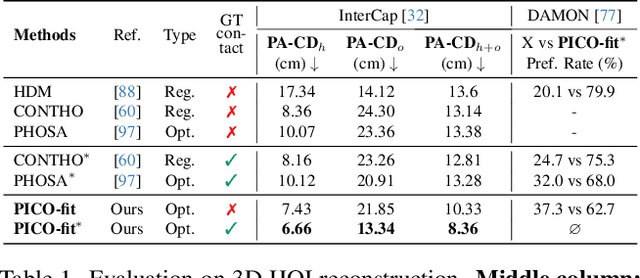
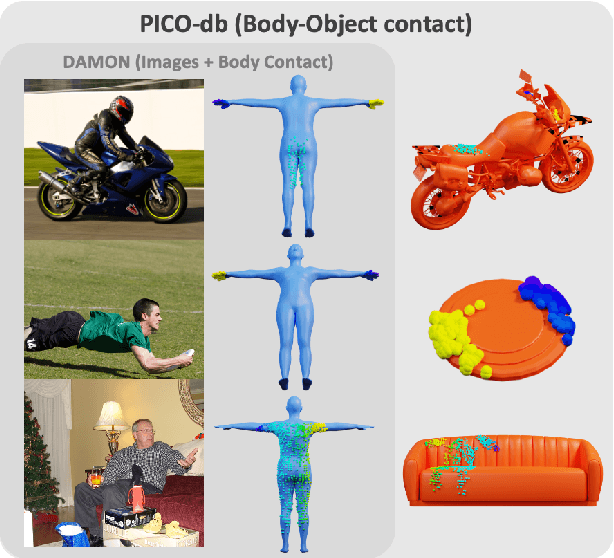


Abstract:Recovering 3D Human-Object Interaction (HOI) from single color images is challenging due to depth ambiguities, occlusions, and the huge variation in object shape and appearance. Thus, past work requires controlled settings such as known object shapes and contacts, and tackles only limited object classes. Instead, we need methods that generalize to natural images and novel object classes. We tackle this in two main ways: (1) We collect PICO-db, a new dataset of natural images uniquely paired with dense 3D contact on both body and object meshes. To this end, we use images from the recent DAMON dataset that are paired with contacts, but these contacts are only annotated on a canonical 3D body. In contrast, we seek contact labels on both the body and the object. To infer these given an image, we retrieve an appropriate 3D object mesh from a database by leveraging vision foundation models. Then, we project DAMON's body contact patches onto the object via a novel method needing only 2 clicks per patch. This minimal human input establishes rich contact correspondences between bodies and objects. (2) We exploit our new dataset of contact correspondences in a novel render-and-compare fitting method, called PICO-fit, to recover 3D body and object meshes in interaction. PICO-fit infers contact for the SMPL-X body, retrieves a likely 3D object mesh and contact from PICO-db for that object, and uses the contact to iteratively fit the 3D body and object meshes to image evidence via optimization. Uniquely, PICO-fit works well for many object categories that no existing method can tackle. This is crucial to enable HOI understanding to scale in the wild. Our data and code are available at https://pico.is.tue.mpg.de.
Supervising 3D Talking Head Avatars with Analysis-by-Audio-Synthesis
Apr 18, 2025
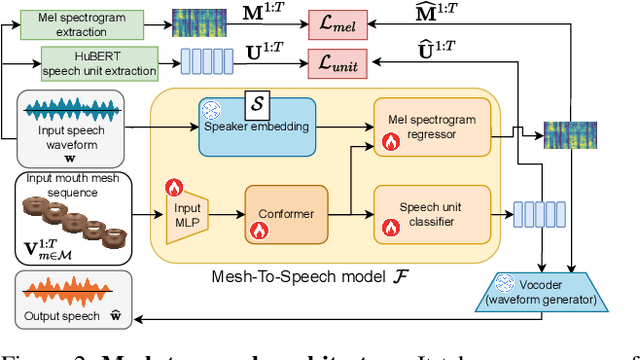

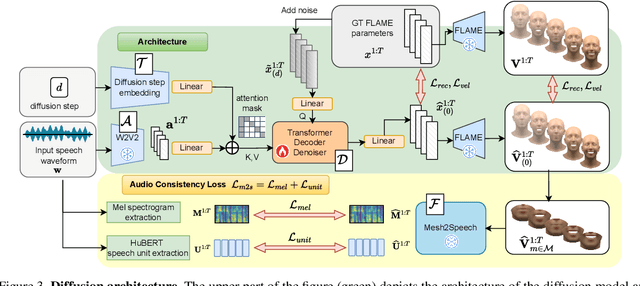
Abstract:In order to be widely applicable, speech-driven 3D head avatars must articulate their lips in accordance with speech, while also conveying the appropriate emotions with dynamically changing facial expressions. The key problem is that deterministic models produce high-quality lip-sync but without rich expressions, whereas stochastic models generate diverse expressions but with lower lip-sync quality. To get the best of both, we seek a stochastic model with accurate lip-sync. To that end, we develop a new approach based on the following observation: if a method generates realistic 3D lip motions, it should be possible to infer the spoken audio from the lip motion. The inferred speech should match the original input audio, and erroneous predictions create a novel supervision signal for training 3D talking head avatars with accurate lip-sync. To demonstrate this effect, we propose THUNDER (Talking Heads Under Neural Differentiable Elocution Reconstruction), a 3D talking head avatar framework that introduces a novel supervision mechanism via differentiable sound production. First, we train a novel mesh-to-speech model that regresses audio from facial animation. Then, we incorporate this model into a diffusion-based talking avatar framework. During training, the mesh-to-speech model takes the generated animation and produces a sound that is compared to the input speech, creating a differentiable analysis-by-audio-synthesis supervision loop. Our extensive qualitative and quantitative experiments demonstrate that THUNDER significantly improves the quality of the lip-sync of talking head avatars while still allowing for generation of diverse, high-quality, expressive facial animations.
St4RTrack: Simultaneous 4D Reconstruction and Tracking in the World
Apr 17, 2025
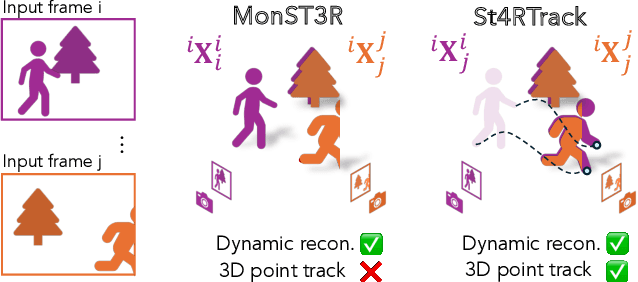
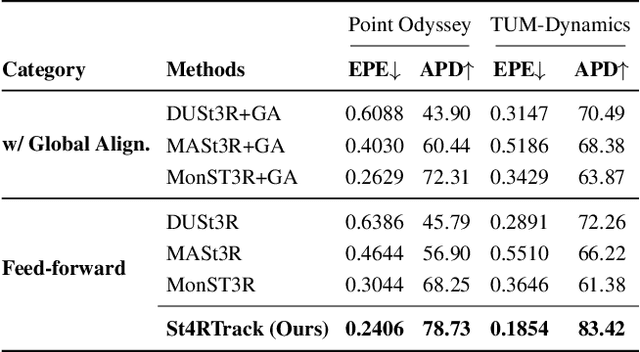
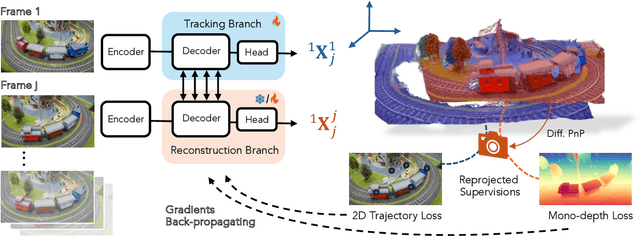
Abstract:Dynamic 3D reconstruction and point tracking in videos are typically treated as separate tasks, despite their deep connection. We propose St4RTrack, a feed-forward framework that simultaneously reconstructs and tracks dynamic video content in a world coordinate frame from RGB inputs. This is achieved by predicting two appropriately defined pointmaps for a pair of frames captured at different moments. Specifically, we predict both pointmaps at the same moment, in the same world, capturing both static and dynamic scene geometry while maintaining 3D correspondences. Chaining these predictions through the video sequence with respect to a reference frame naturally computes long-range correspondences, effectively combining 3D reconstruction with 3D tracking. Unlike prior methods that rely heavily on 4D ground truth supervision, we employ a novel adaptation scheme based on a reprojection loss. We establish a new extensive benchmark for world-frame reconstruction and tracking, demonstrating the effectiveness and efficiency of our unified, data-driven framework. Our code, model, and benchmark will be released.
PromptHMR: Promptable Human Mesh Recovery
Apr 08, 2025



Abstract:Human pose and shape (HPS) estimation presents challenges in diverse scenarios such as crowded scenes, person-person interactions, and single-view reconstruction. Existing approaches lack mechanisms to incorporate auxiliary "side information" that could enhance reconstruction accuracy in such challenging scenarios. Furthermore, the most accurate methods rely on cropped person detections and cannot exploit scene context while methods that process the whole image often fail to detect people and are less accurate than methods that use crops. While recent language-based methods explore HPS reasoning through large language or vision-language models, their metric accuracy is well below the state of the art. In contrast, we present PromptHMR, a transformer-based promptable method that reformulates HPS estimation through spatial and semantic prompts. Our method processes full images to maintain scene context and accepts multiple input modalities: spatial prompts like bounding boxes and masks, and semantic prompts like language descriptions or interaction labels. PromptHMR demonstrates robust performance across challenging scenarios: estimating people from bounding boxes as small as faces in crowded scenes, improving body shape estimation through language descriptions, modeling person-person interactions, and producing temporally coherent motions in videos. Experiments on benchmarks show that PromptHMR achieves state-of-the-art performance while offering flexible prompt-based control over the HPS estimation process.
InteractVLM: 3D Interaction Reasoning from 2D Foundational Models
Apr 07, 2025Abstract:We introduce InteractVLM, a novel method to estimate 3D contact points on human bodies and objects from single in-the-wild images, enabling accurate human-object joint reconstruction in 3D. This is challenging due to occlusions, depth ambiguities, and widely varying object shapes. Existing methods rely on 3D contact annotations collected via expensive motion-capture systems or tedious manual labeling, limiting scalability and generalization. To overcome this, InteractVLM harnesses the broad visual knowledge of large Vision-Language Models (VLMs), fine-tuned with limited 3D contact data. However, directly applying these models is non-trivial, as they reason only in 2D, while human-object contact is inherently 3D. Thus we introduce a novel Render-Localize-Lift module that: (1) embeds 3D body and object surfaces in 2D space via multi-view rendering, (2) trains a novel multi-view localization model (MV-Loc) to infer contacts in 2D, and (3) lifts these to 3D. Additionally, we propose a new task called Semantic Human Contact estimation, where human contact predictions are conditioned explicitly on object semantics, enabling richer interaction modeling. InteractVLM outperforms existing work on contact estimation and also facilitates 3D reconstruction from an in-the wild image. Code and models are available at https://interactvlm.is.tue.mpg.de.
ETCH: Generalizing Body Fitting to Clothed Humans via Equivariant Tightness
Mar 13, 2025Abstract:Fitting a body to a 3D clothed human point cloud is a common yet challenging task. Traditional optimization-based approaches use multi-stage pipelines that are sensitive to pose initialization, while recent learning-based methods often struggle with generalization across diverse poses and garment types. We propose Equivariant Tightness Fitting for Clothed Humans, or ETCH, a novel pipeline that estimates cloth-to-body surface mapping through locally approximate SE(3) equivariance, encoding tightness as displacement vectors from the cloth surface to the underlying body. Following this mapping, pose-invariant body features regress sparse body markers, simplifying clothed human fitting into an inner-body marker fitting task. Extensive experiments on CAPE and 4D-Dress show that ETCH significantly outperforms state-of-the-art methods -- both tightness-agnostic and tightness-aware -- in body fitting accuracy on loose clothing (16.7% ~ 69.5%) and shape accuracy (average 49.9%). Our equivariant tightness design can even reduce directional errors by (67.2% ~ 89.8%) in one-shot (or out-of-distribution) settings. Qualitative results demonstrate strong generalization of ETCH, regardless of challenging poses, unseen shapes, loose clothing, and non-rigid dynamics. We will release the code and models soon for research purposes at https://boqian-li.github.io/ETCH/.
 Add to Chrome
Add to Chrome Add to Firefox
Add to Firefox Add to Edge
Add to Edge